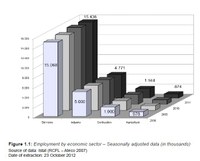|
1.1 Population and demographics
According to EUROSTAT, the Italian population was over 60 million in 2011. The population increase was mainly due to the migratory flows which have occurred in the last few years and which counterbalanced to some extent the drop in the birth rate and population ageing. In fact, dependency ratio projections for aged people show that the indicator value was slightly higher (30.78%) than the corresponding EU27 already in 2010, that it increased progressively in the following years, constantly maintaining a positive gap compared to the European population and will eventually rise to 50% in 2040.
Back to index
1.2 Economy and labour market indicators
Under the negative impact of the economic crisis, the average number of employees in Italy has dropped to 22.9 million and the employment rate to 56.9% (2011). In particular, in 2011 the employment rate was 56.9%, the unemployment rate 8.4% (unchanged since the previous year) and the activity rate had fallen from 63% in 2008 to 62.2%. At the same time, indicators on unemployed people show an unemployment rate that is generally higher compared to the correspondent EU27 values for the 15-24 age group at all educational attainment levels, whereas it is lower for the 25-49 and 50-64 age groups at all educational levels, except for ISCED 5-6, age group 25-49 (i.e. 6.3 in Italy as compared to 5.5 in the EU in 2011).
Back to index
1.3. Educational attainment of the population
Results from investment in education can be evaluated in terms of ability to access and maintain one's employment, job quality and profitability. The results, both in terms of probability of employment and wage differentials, show the existence of an Italian problem which explains the position of our country towards the bottom of a hypothetical ranking of the European countries. In Italy the share of people aged 25-64 that have acquired at least a secondary education diploma is about 17.5 percentage points lower than the EU27 average (56% in Italy and 73.4% in the EU27). The gap is still significant for the 25-64 age group with university degrees (14.9% in Italy, 26.8% EU27 average) and is even wider for the 25-34 age group (21.0% in Italy, 34.2% EU27 average).
Back to index
|
Table
Total population (on 1st January), 2006, 2009, 2010, 2011

Projected old-age dependency ratio %

Employment by economic sector – Seasonally adjusted data (in thousands)

Early school leavers: Percentage of the population aged 18-24 with at most lower secondary education and not in further education or training

|